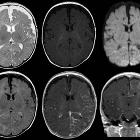fetal intracranial calcification
Fetal intracranial calcification refers to intracranial calcification detected in utero. This can arise from a number of pathologies which include:
- in utero infections
- fetal toxoplasmosis infection: calcification tends to be randomly distributed
- fetal cytomegalovirus infection: calcification tends to be periventricular in distribution
- calcifications are much less in herpes simplex and rubella infection
- intracranial tumors associated with calcification: intracranial teratoma
- certain phakomatoses
- Sturge-Weber syndrome: gyriform pattern of cortical calcifications
- tuberous sclerosis: rare to have calcification present in utero
- sequelae of an in utero intracranial hemorrhage
- pseudo-TORCH syndrome
- postnatal infections
Radiographic features
Antenatal ultrasound
Calcification tends to manifest as brightly echogenic foci within the fetal brain.
Siehe auch:
- Tuberöse Sklerose
- Sturge-Weber-Krabbe-Syndrom
- intrakraniale Teratome
- Phakomatosen
- in utero infection
- connatale Zytomegalie
- fetal toxoplasmosis infection
und weiter:

 Assoziationen und Differentialdiagnosen zu fetal intracranial calcification:
Assoziationen und Differentialdiagnosen zu fetal intracranial calcification:




